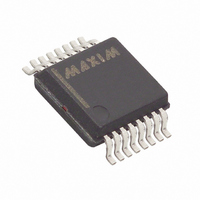MAX1452CAE+ Maxim Integrated Products, MAX1452CAE+ Datasheet - Page 8

MAX1452CAE+
Manufacturer Part Number
MAX1452CAE+
Description
IC SENSOR SIGNAL COND 16-SSOP
Manufacturer
Maxim Integrated Products
Type
Signal Conditionerr
Datasheet
1.MAX1452CAE.pdf
(25 pages)
Specifications of MAX1452CAE+
Input Type
Analog
Output Type
Analog
Interface
Serial
Current - Supply
2.5mA
Mounting Type
Surface Mount
Package / Case
16-SSOP
Lead Free Status / RoHS Status
Lead free / RoHS Compliant
Writing 16-bit calibration coefficients into the offset TC
and FSOTC registers compensates first-order tempera-
ture errors. The piezoresistive sensor is powered by a
current source resulting in a temperature-dependent
bridge voltage due to the sensor's temperature resis-
tance coefficient (TCR). The reference inputs of the off-
set TC DAC and FSOTC DAC are connected to the
bridge voltage. The DAC output voltages track the
bridge voltage as it varies with temperature, and by
varying the offset TC and FSOTC digital code a portion
of the bridge voltage, which is temperature dependent,
is used to compensate the first order temperature
errors.
The internal feedback resistors (R
FSO temperature compensation are optimized to 75kΩ
for silicon piezoresistive sensors. However, since the
required feedback resistor values are sensor dependent,
external resistors may also be used. The internal resis-
tors selection bit in the configuration register selects
between internal and external feedback resistors.
To calculate the required offset TC and FSOTC com-
pensation coefficients, two test-temperatures are need-
ed. After taking at least two measurements at each
temperature, calibration software (in a host computer)
calculates the correction coefficients and writes them to
the internal EEPROM.
With coefficients ranging from 0000hex to FFFFhex and
a +5V reference, each DAC has a resolution of 76µV.
Two of the DACs (offset TC and FSOTC) utilize the sen-
sor bridge voltage as a reference. Since the sensor
bridge voltage is approximately set to +2.5V the FSOTC
and offset TC exhibit a step size of less than 38µV.
Low-Cost Precision Sensor
Signal Conditioner
Figure 2. Basic Ratiometric Output Configuration
8
_______________________________________________________________________________________
Temperature Compensation
Linear and Nonlinear
SENSOR
ISRC
and R
5
6
4
STC
BDR
INP
INM
TEST V
) for
8
MAX1452
V
DD
SS
7
3
FSOTC
V
ISRC
OUT
DDF
For high accuracy applications (errors less than
0.25%), the first-order offset and FSO TC error should
be compensated with the offset TC and FSOTC DACs,
and the residual higher order terms with the lookup
table. The offset and FSO compensation DACs provide
unique compensation values for approximately 1.5°C of
temperature change as the temperature indexes the
address pointer through the coefficient lookup table.
Changing the offset does not effect the FSO, however
changing the FSO affects the offset due to nature of the
bridge. The temperature is measured on both the
MAX1452 die and at the bridge sensor. It is recom-
mended to compensate the first-order temperature
errors using the bridge sensor temperature.
Ratiometric output configuration provides an output that
is proportional to the power supply voltage. This output
can then be applied to a ratiometric ADC to produce a
digital value independent of supply voltage.
Ratiometricity is an important consideration for battery-
operated instruments, automotive, and some industrial
applications.
The MAX1452 provides a high-performance ratiometric
output with a minimum number of external components
(Figure 2). These external components include the fol-
lowing:
•
•
•
9
2
16
1
One supply bypass capacitor.
One optional output EMI suppression capacitor.
Two optional resistors, R
sensor bridge types.
R
R
STC
ISRC
0.1μF
0.1μF
GND
+5V V
OUT
Typical Ratiometric
DD
Operating Circuit
ISRC
and R
STC
, for special











